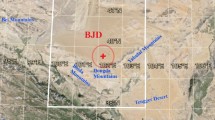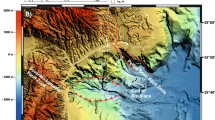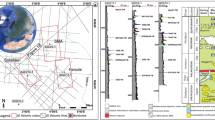Abstract
IT is now widely believed that a large impact occurred on the Earth at the end of the Cretaceous period, and that the buried Chicxulub structure in Yucatán, Mexico, is the resulting crater24. Knowledge of the size and internal structure of the Chicxulub crater is necessary for quantifying the effects of the impact on the Cretaceous environment. Although much information bearing on the crater's structure is available, diameter estimates range from 170 to 300 km (refs 1á¤-7), corresponding to an order of magnitude variation in impact energy. Here we show the diameter of the crater to be ˜180 km by examining the horizontal gradient of the Bouguer gravity anomaly over the structure. This size is confirmed by the distribution of karst features in the Yucatan region (mainly water-filled sinkholes, known as cenotes). The coincidence of cenotes and peripheral gravity-gradient maxima suggests that cenote formation is closely related to the presence of slump faults near the crater rim.
This is a preview of subscription content, access via your institution
Access options
Subscribe to this journal
Receive 51 print issues and online access
$199.00 per year
only $3.90 per issue
Buy this article
- Purchase on Springer Link
- Instant access to full article PDF
Prices may be subject to local taxes which are calculated during checkout
Similar content being viewed by others
References
Hildebrand, A. R. et al. Geology 19, 867–871 (1991).
Pilkington, M., Hildebrand, A. R. & Ortiz-Aleman, C. J. geophys. Res. 99, 13147–13162 (1994).
Hildebrand, A. R., Connors, M., Pilkington, M., Ortiz-Aleman, C. & Chavez, R. E. Rev. Soc. Mex. Paleo. 7, 59–68 (1994).
Espindola, J. M., Mena, M., de La Fuente, M. & Campos-Enriquez, J. O. Phys. Earth planet. Inter. (in the press).
Pope, K. O., Ocampo, A. C. & Duller, C. E. Earth Moon Planets 63, 93–104 (1993).
Sharpton, V. L. et al. Science 261, 1564–1567 (1993).
Camargo-Zanoguera, A. & Suárez-Reynoso, G. Bol. Asoc. Mex. Géof. Expl. 34, 1–28 (1994).
Sharpton, V. L., Grieve, R. A. F., Thomas, M. D. & Halpenny, J. F. Geophys. Res. Lett. 14, 808–811 (1987).
Bunting, J. A., de Laeter, J. R. & Libby, W. G. Annual Report 1979 81–85 (Geol. Surv. of Western Australia, Perth, Western Australia, 1980).
Ness, G. E., Dauphin, J. P., Garcia-Abdeslem, J. & Alvarado-Omana, M. E. Map and Chart Series MCH073 (Geol. Soc. Am., Boulder, CO, 1991).
Pilkington, M., Grieve, R. A. F., Rupert, J. D. & Halpenny, J. Map 1807A (Geol. Surv. Can, Ottawa, 1992).
Melosh, H. J. Impact Cratering: A Geologic Process 245 (Oxford Univ. Press, New York, 1989).
Cué, A. V. Bol. Asoc. Mex. Geol. Petrol. 5, 285–290 (1953).
Pearce, S. J. & Melosh, H. J. Geophys. Res. Lett. 13, 1419–1422 (1986).
Marin, L. E. thesis, Northern Illinois Univ. (1990).
De Landa, D. Yacután Before and after The Conquest 184 (trans. by Gates, W., San Fernando, Mérida, México, 1556).
Lopez-Ramos, E. The Gulf of Mexico and the Caribbean (eds Nairn, A. E. M. & Stehli, F. G.) 257–282 (Plenum, New York, 1975).
Cartas Geologica, Calkini F15-9-12, Tizimin, F16-7, Merida, F16-10 (Institute Nacional de Estadistica, Geografia e Informática, Mexico City, 1984).
Pope, K. O., Ocampo, A. C. & Duller, C. E. Nature 351, 105 (1991).
Perry, E. C., Marin, L., McClain, J. & Veláquez, G. Geology 23, 17–20 (1995).
Johnson, K. S. & Smith, D. (abstr.) in Ames Structure and Similar Features—A Workshop 36 (Oklahoma Geol. Surv., Norman, OK, 1995).
Hildebrand, A. R. thesis, Univ. Arizona, (1992).
Sandwell, D. T., Yale, M. M. & Smith, W. H. F. (abstr.) Eos 75, 155 (1994).
Smit, J. Nature 368, 809–810 (1994).
Author information
Authors and Affiliations
Rights and permissions
About this article
Cite this article
Hildebrand, A., Pilkington, M., Connors, M. et al. Size and structure of the Chicxulub crater revealed by horizontal gravity gradients and cenotes. Nature 376, 415–417 (1995). https://doi.org/10.1038/376415a0
Received:
Accepted:
Issue Date:
DOI: https://doi.org/10.1038/376415a0
This article is cited by
-
A steeply-inclined trajectory for the Chicxulub impact
Nature Communications (2020)
-
Unmanned aerial vehicle observations of water surface elevation and bathymetry in the cenotes and lagoons of the Yucatan Peninsula, Mexico
Hydrogeology Journal (2018)
-
On the chronology of lunar origin and evolution
The Astronomy and Astrophysics Review (2013)
-
Electrical Imaging of Impact Structures
Surveys in Geophysics (2012)
-
The key role of the chemolimnion in meromictic cenotes of the Yucatan Peninsula, Mexico
Hydrobiologia (2011)
Comments
By submitting a comment you agree to abide by our Terms and Community Guidelines. If you find something abusive or that does not comply with our terms or guidelines please flag it as inappropriate.



